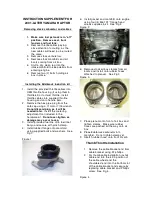
TOE ADJUSTMENT
Toe is adjusted by changing the tie rod length. Loosen right and left
tie rod end lock nuts first and then rotate right and left tie rods by
the same amount to align toe-in to specification. In this adjustment,
right and left tie rods should become equal in length (“A” in left fig-
ure).
Before rotating tie rods, apply grease between tie rods and rack
boots so that boots won’t be twisted.
After adjustment, tighten lock nuts to specified torque and make
sure that rack boots are not twisted.
Tightening Torque
(a): 45 N·m (4.5 kg-m, 32.5 lb-ft)
CAMBER AND CASTER ADJUSTMENT
Should camber or caster be found out of specifications upon in-
spection, locate its cause first. If it is in damaged, loose, bent,
dented or worn suspension parts, they should be replaced. If it is
in vehicle body, repair it so as to attain specifications.
To prevent possible incorrect reading of camber or caster, vehicle
front end must be moved up and down a few times before inspec-
tion.
3A-2
FRONT END ALIGNMENT
PRELIMINARY CHECKS PRIOR TO ADJUSTING FRONT ALIGNMENT
Steering and vibration complaints are not always the result of improper alignment. An additional item to be checked
is the possibility of tire lead due to worn or improperly manufactured tires. “Lead” is the deviation of the vehicle from
a straight path on a level road without hand pressure on the steering wheel. Section 3 of this manual contains a
procedure for determining the presence of a tire lead problem. Before making any adjustment affecting toe setting,
the following checks and inspections should be made to ensure correctness of alignment readings and alignment
adjustments:
1) Check all tires for proper inflation pressures and approximately the same tread wear.
2) Check for loose of ball joints. Check tie rod ends; if excessive looseness is noted, it must be corrected before
adjusting.
3) Check for run-out of wheels and tires.
4) Check vehicle trim heights; if out of limits and a correction is to be made, it must be made before adjusting toe.
5) Check for loose of suspension arms.
6) Check for loose or missing stabilizer bar attachments.
7) Consideration must be given to excess loads, such as tool boxes. If this excess load is normally carried in ve-
hicle, it should remain in vehicle during alignment checks.
8) Consider condition of equipment being used to check alignment and follow manufacturer’s instructions.
9) Regardless of equipment used to check alignment, vehicle must be on a level surface both fore and aft and
transversely.
Summary of Contents for RA410
Page 262: ...ENGINE MECHANICAL 6A4 3...
Page 388: ...ENGINE AND EMISSION CONTROL SYSTEM 6E1 23 Blank...
Page 392: ...ENGINE AND EMISSION CONTROL SYSTEM 6E1 27 Fig for Step 3 2 3 1...
Page 399: ...6E1 34 ENGINE AND EMISSION CONTROL SYSTEM Fig for Step 2...
Page 552: ...AUTOMATIC TRANSMISSION 7B 25...
Page 553: ...7B 26 AUTOMATIC TRANSMISSION...
Page 663: ...BODY SERVICE 9 21 BUMPERS Front bumper Rear bumper...
Page 761: ...Prepared by Overseas Service Department 1st Ed May 1998 Printed in Japan Printing May 1999 610...
















































